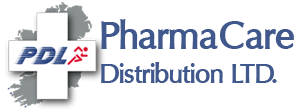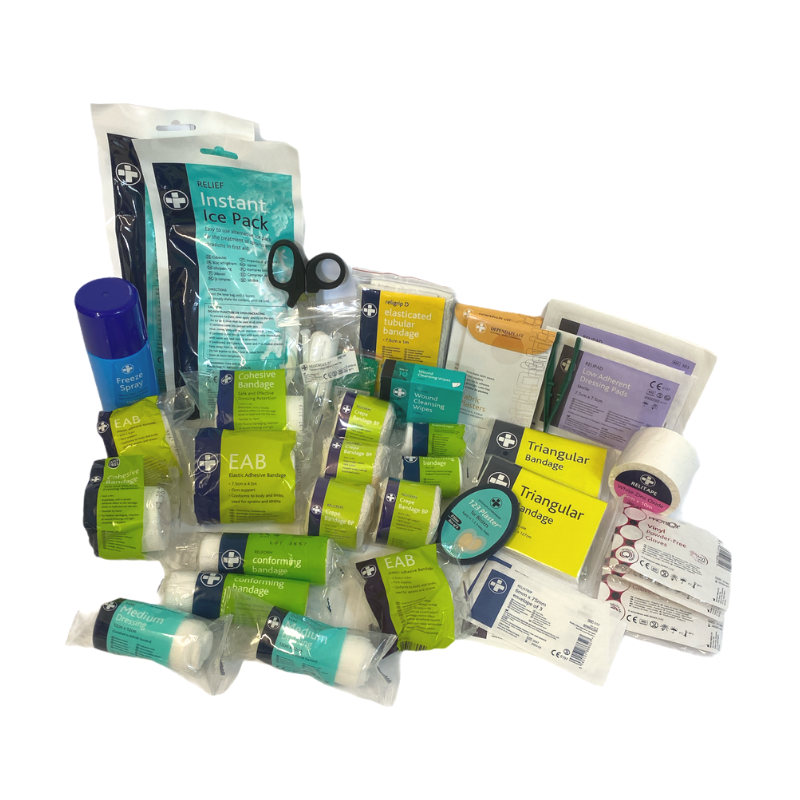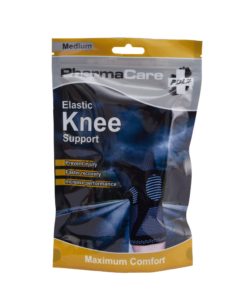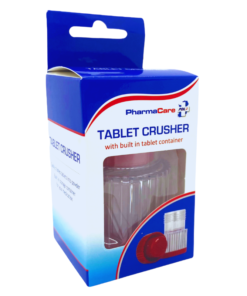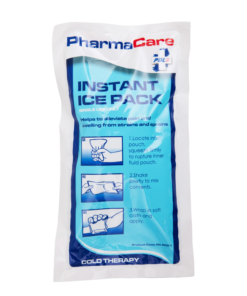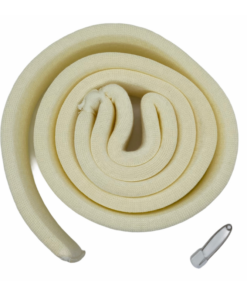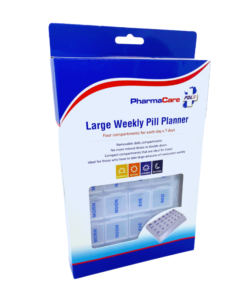Description
Description
The Pharmacare Brand Medium Red Sports Bag is a filled sports bag that is ideal for carrying around while aiding to injuries, making it ideal for use at matches or training. There are two side pockets, along with a front pocket in the first aid bag and there are 3 compartments in the main section of the bag, as well as pockets on the inside. The dividers are velcro and can be adjusted to any desired compartment sizes that are needed. The bag is red in colour and comes with a shoulder strap that can be attached to ensure ease of use for on the go treatment.
Bag measurements: 20cm (Height) x 36cm (Length) x 18cm (Width).
The Pharmacare Brand Medium Red Sports Bag contains the following:
- 2 x Reliform Conforming Bandage (7.5cm x 4m)
- 2 x Reliform Conforming Bandage (5cm x 4m)
- 4 x Relicrepe Crepe Bandage BP (5cm x 4.5m)
- 2 x Single Use Triangular Bandage (90 x 127cm)
- 1 x 150ml Ice Spray
- 1 x White Latex Free Cohesive Bandage (5cm x 4m)
- 1 x White Latex Free Cohesive Bandage (7.5cm x 4m)
- 2 x Medium HSE Dressing (12cm x 12cm)
- 1 x Non-Sterile Plastic Forceps
- 3 x Single Pair Vinyl Powder-Free Gloves (Medium)
- 2 x Relief Instant Ice Pack
- 1 x Elastic Adhesive Bandage (2.5cm x 4.5m)
- 1 x Elastic Adhesive Bandage (5cm x 4.5m)
- 1 x Elastic Adhesive Bandage (7.5cm x 4.5m)
- 2 x Relipad Low Adherent Dressing Pads (10cm x 10cm)
- 2 x Relipad Low Adherent Dressing Pads (7.5cm x 7.5cm)
- 1 x Reliwipe Saline Cleansing Wipes (10 Pack)
- 1 x Dependaplast Blister Plasters (5 Pack)
- 2 Dependaplast Advanced Fabric Plasters (20 Pack)
- 12 x Safety Pins
- 1 x 6” Universal Shears
- 1 x Religrip Size D Elasticated Tubular Bandage (1 Metre)
- 1 x Religauze Tubular Gauze with Applicator (1 Metre)
- 2 x Skin Closure Strips (3mm x 75mm, 5 strips)
- 2 x Skin Closure Strips (6mm x 75mm 3 strips)
- 1 x Relitape White Zinc Oxide Tape (5cm x 10m)
Uses
The Pharmacare Brand Medium Red Sports Bag is used for on the go treatment and can be carried around while aiding to injuries, making it ideal for use at matches or training.
Application
What to do in an emergency:
Priorities:
• Assess the situation – do not put yourself in danger
• Make the area safe
• Assess all casualties and attend any unconscious casualties first
• Send for help – do not delay
Check for a response:
• Gently shake the casualty’s shoulders and ask loudly: Are you all right?
• If there is no response, your priorities are to:
o Shout for help
o Open the airway
o Check for normal bleeding
o Take appropriate action
Follow the A, B, C’s:
A: Airway
• To open the airway, place your hand on the casualty’s forehead and gently tilt the head back
• Lift the chin with two fingertips
B: Breathing
• Look, listen and feel for normal breathing for no more than 10 seconds:
o Look for chest movement
o Listen at the casualty’s mouth for breath sounds
o Feel for air on your cheek
• If the casualty is breathing normally:
o Place in the recovery position
o Get help
o Check for continued breathing
• If the casualty is not breathing normally:
o Get help and call for an AED if available
o Start chest compressions
C: CPR
• To start chest compressions, lean over the casualty and with your arms straight, press down on the centre of the breastbone 5 – 6cm, then release the pressure
• Repeat at a rate of 100 – 120 times a minute
• After 30 compressions, open the airway again
• If an AED is available, use in accordance with your training / manufacturer’s instructions
• Pinch the casualty’s nose closed and allow the mouth to open
• Take a normal breath and place your mouth around the casualty’s mouth, making a good seal
• Blow steadily into the mouth while watching for chest rising
• Remove your mouth from the casualty and watch for the chest falling
• Give a second breath and then start 30 compressions again without delay
• Continue with chest compressions and rescue breaths in a ration of 30:2 until qualified help takes over or the casualty starts breathing normally
Severe Bleeding:
• Apply direct pressure to the wound
• Raise and support the injured part (unless broken)
• Apply a dressing and bandage firmly in place
Broken Bones and Spinal Injuries:
• If a broken bone or spinal injury is suspected, obtain expert help
• Do not move casualties unless they are in immediate danger
Burns:
• Burns can be serious, so if in doubt seek medical help
• Cool the affected part of the body with cold water until the pain is relieved
• Thorough cooling may take 10 minutes or more, but this must not delay taking the casualty to hospital
• Certain chemicals may seriously irritate or damage the skin. Avoid contaminating yourself with the chemical. Treat in the same way as for other burns but flood the affected area with water for 20 minutes. Continue treatment even in the way to the hospital, if necessary. Remove any contaminated clothing which is not stuck to the skin, using scissors if necessary.
Eye Injuries:
• All eye injuries are potentially serious
• If there is something in the eye, wash out the eye with clean water or sterile fluid from a sealed container to remove loose material
• Do not attempt to remove anything that is embedded in the eye
• If chemicals are involved, flush the eye with water or sterile fluid for at least 10 minutes, while gently holding the eyelids open. Ask the casualty to hold a pad over the injured eye and send them to the hospital
Record Keeping:
• It is good practice to use a book for recording any incidents involving injuries or illness which you have attended. Include the following information in your entry:
o The date, time and place of the incident
o The name and job of the injured or ill person
o Details of the injury / illness and any first aid given
o What happened to the casualty immediately afterwards (e.g. went back to work, went home, went to hospital)
o The name and signature of the person dealing with the incident
This information can help identify accident trends and possible areas for improvement in the control of health and safety risks
